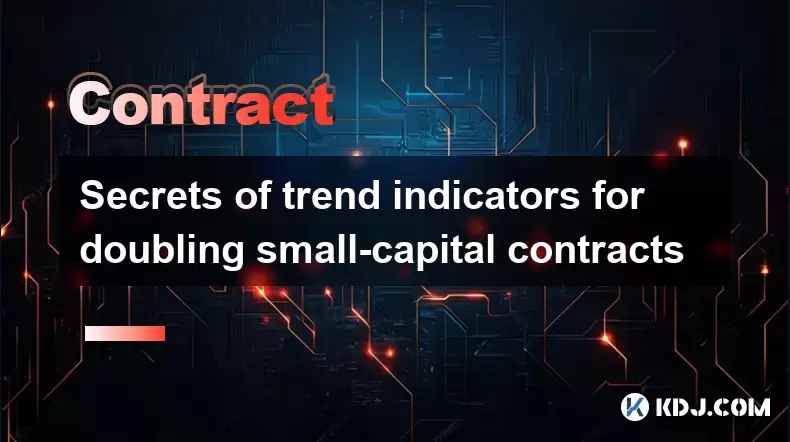-
 bitcoin
bitcoin $87959.907984 USD
1.34% -
 ethereum
ethereum $2920.497338 USD
3.04% -
 tether
tether $0.999775 USD
0.00% -
 xrp
xrp $2.237324 USD
8.12% -
 bnb
bnb $860.243768 USD
0.90% -
 solana
solana $138.089498 USD
5.43% -
 usd-coin
usd-coin $0.999807 USD
0.01% -
 tron
tron $0.272801 USD
-1.53% -
 dogecoin
dogecoin $0.150904 USD
2.96% -
 cardano
cardano $0.421635 USD
1.97% -
 hyperliquid
hyperliquid $32.152445 USD
2.23% -
 bitcoin-cash
bitcoin-cash $533.301069 USD
-1.94% -
 chainlink
chainlink $12.953417 USD
2.68% -
 unus-sed-leo
unus-sed-leo $9.535951 USD
0.73% -
 zcash
zcash $521.483386 USD
-2.87%
Secrets of trend indicators for doubling small-capital contracts
Use trend indicators like Moving Averages, RSI, and MACD to double small-capital crypto contracts by identifying bullish trends and setting strategic entry and exit points.
Jun 07, 2025 at 09:35 pm

In the fast-paced world of cryptocurrency trading, small-capital contracts can be a gateway to substantial profits if managed correctly. The use of trend indicators is one of the most effective strategies for doubling these small investments. This article will delve into the secrets of utilizing trend indicators to maximize the potential of small-capital contracts, providing traders with the knowledge needed to navigate the volatile crypto market successfully.
Understanding Trend Indicators
Trend indicators are tools used by traders to identify the direction and strength of a market trend. These indicators can be crucial for making informed trading decisions, especially when dealing with small-capital contracts where every move counts. Moving Averages (MA), Relative Strength Index (RSI), and Moving Average Convergence Divergence (MACD) are among the most popular trend indicators used in cryptocurrency trading.
Each of these indicators offers unique insights into market trends. Moving Averages smooth out price data to form a single flowing line, making it easier to identify the direction of the trend. RSI measures the speed and change of price movements, helping traders understand if a cryptocurrency is overbought or oversold. MACD is a trend-following momentum indicator that shows the relationship between two moving averages of a cryptocurrency's price.
Selecting the Right Trend Indicator for Small-Capital Contracts
When it comes to doubling small-capital contracts, selecting the right trend indicator is crucial. For beginners, Moving Averages might be the simplest to understand and apply. A common strategy involves using a combination of short-term and long-term moving averages, such as the 50-day and 200-day MAs. When the short-term MA crosses above the long-term MA, it signals a potential bullish trend, which could be an opportune time to enter a long position.
For more experienced traders, MACD can provide deeper insights into market momentum. The MACD line crossing above the signal line is often seen as a bullish signal, suggesting it might be a good time to buy. Conversely, when the MACD line crosses below the signal line, it could be a sign to sell or short the cryptocurrency.
Implementing Trend Indicators in Trading Strategies
To effectively use trend indicators for doubling small-capital contracts, traders need to implement a well-thought-out trading strategy. Here’s how you can do it:
- Identify the Trend: Use your chosen trend indicator to determine the current market trend. For example, if you are using Moving Averages, look for the short-term MA crossing above the long-term MA as a sign of a bullish trend.
- Enter the Market: Once you have identified a bullish trend, consider entering a long position. If you are using a small-capital contract, ensure that your entry point aligns with your risk management strategy.
- Set Stop-Loss and Take-Profit Levels: To protect your investment, set a stop-loss order at a level that minimizes your risk. Similarly, set a take-profit level to secure your gains once the price reaches your target.
- Monitor and Adjust: Keep a close eye on the market and your trend indicators. If the trend starts to reverse, be prepared to exit your position to lock in profits or minimize losses.
Case Study: Doubling a Small-Capital Contract Using Trend Indicators
Let’s look at a practical example of using trend indicators to double a small-capital contract. Suppose you have a $100 investment in Bitcoin and want to use the MACD indicator to guide your trading decisions.
- Initial Analysis: You observe that the MACD line has recently crossed above the signal line, indicating a potential bullish trend.
- Entry Point: You decide to enter a long position at the current price of $50,000 per Bitcoin, investing your $100 in a small-capital contract.
- Setting Stop-Loss and Take-Profit: You set a stop-loss at $48,000 to limit your potential loss to $40. Your take-profit level is set at $55,000, aiming to double your investment.
- Monitoring: As the market moves, you keep an eye on the MACD. If the bullish trend continues, you may see the price reach your take-profit level, doubling your investment to $200.
Combining Multiple Trend Indicators
For a more robust trading strategy, consider combining multiple trend indicators. Using Moving Averages alongside RSI can provide a clearer picture of market trends and potential entry and exit points. Here’s how you can do it:
- Moving Averages: Use the crossover of short-term and long-term MAs to identify the trend direction.
- RSI: Monitor the RSI to determine if the market is overbought or oversold. An RSI above 70 might indicate an overbought market, suggesting a potential price correction, while an RSI below 30 could signal an oversold market, indicating a possible price rebound.
- Combining Insights: If the short-term MA crosses above the long-term MA and the RSI is below 70, it might be a good time to enter a long position. Conversely, if the short-term MA crosses below the long-term MA and the RSI is above 30, consider exiting your position.
Risk Management in Small-Capital Trading
Effective risk management is essential when trading small-capital contracts. Here are some key principles to keep in mind:
- Position Sizing: Never risk more than a small percentage of your total capital on a single trade. A common rule of thumb is to risk no more than 1-2% of your capital per trade.
- Diversification: Spread your investments across different cryptocurrencies to reduce the impact of any single asset’s volatility.
- Emotional Discipline: Stick to your trading plan and avoid making impulsive decisions based on short-term market fluctuations.
By understanding and applying these principles, traders can better manage the risks associated with small-capital contracts and increase their chances of doubling their investments.
Frequently Asked Questions
Q1: Can trend indicators be used effectively with all cryptocurrencies?A1: While trend indicators can be applied to any cryptocurrency, their effectiveness may vary depending on the specific asset’s volatility and market behavior. Highly volatile cryptocurrencies may produce more false signals, requiring traders to adjust their strategies accordingly.
Q2: How often should I check my trend indicators when trading small-capital contracts?A2: The frequency of checking trend indicators depends on your trading style. For day traders, checking indicators every few minutes to hours may be necessary. For swing traders, checking once or twice a day might be sufficient. Always ensure that your monitoring aligns with your overall trading strategy.
Q3: Are there any specific trend indicators that work better for small-capital contracts?A3: While no single trend indicator is universally better for small-capital contracts, Moving Averages are often favored for their simplicity and effectiveness. However, combining multiple indicators like MACD and RSI can provide a more comprehensive view of market trends, which is beneficial for managing small investments.
Q4: How can I improve my skills in using trend indicators for small-capital contracts?A4: Improving your skills involves continuous learning and practice. Start by backtesting different trend indicators on historical data to understand their performance. Additionally, consider using demo accounts to practice trading without risking real money. Joining trading communities and forums can also provide valuable insights and feedback from experienced traders.
Disclaimer:info@kdj.com
The information provided is not trading advice. kdj.com does not assume any responsibility for any investments made based on the information provided in this article. Cryptocurrencies are highly volatile and it is highly recommended that you invest with caution after thorough research!
If you believe that the content used on this website infringes your copyright, please contact us immediately (info@kdj.com) and we will delete it promptly.
- GeeFi Unleashes Game-Changing Staking with Up to 55% High-Yield APR for GEE Holders
- 2025-12-21 09:35:02
- Fiji's Currency Gets a Fresh Look: New Polymer Designs and Enhanced Circulation
- 2025-12-21 06:55:01
- Cathie Wood's Ark Invest Adjusts Tesla Investment, Eyes Crypto Opportunities
- 2025-12-21 06:45:02
- Navigating the New Frontier: Crypto Tax Bill, Stablecoins, and De Minimis Rules Take Center Stage
- 2025-12-21 03:35:01
- COIN's Compass: Coinbase Stock Market Performance Charting New Territories Amidst Evolving Crypto Landscape
- 2025-12-20 12:45:01
- GeeFi Rockets Towards 100x Returns, While Ripple Makes Strategic Stablecoin Moves
- 2025-12-20 06:15:02
Related knowledge

How Does the Liquidation Engine Work on a Crypto Exchange?
Dec 19,2025 at 05:59am
Core Mechanism of Margin Liquidation1. When a trader opens a leveraged position, the exchange assigns an initial margin requirement and a maintenance ...

Why is Risk-to-Reward Ratio Crucial in Futures Trading?
Dec 08,2025 at 01:20am
Risk-to-Reward Ratio Defined1. The risk-to-reward ratio quantifies the potential loss against the potential gain for a single futures trade. It is cal...

A Step-by-Step Guide on How to Short Bitcoin with Futures.
Dec 07,2025 at 06:39pm
Understanding Bitcoin Futures Contracts1. Bitcoin futures are standardized agreements to buy or sell BTC at a predetermined price and date in the futu...

Understanding the Relationship Between Leverage and Margin.
Dec 14,2025 at 02:39am
Core Mechanics of Leverage in Crypto Trading1. Leverage allows traders to control a larger position size than their available capital would normally p...

How to Reduce Trading Fees on Your Futures Account.
Dec 11,2025 at 01:20pm
Understanding Fee Structures in Futures Trading1. Exchanges apply distinct fee models based on order type—maker orders add liquidity and receive rebat...

What is the Difference Between Futures and Options Trading?
Dec 18,2025 at 12:40pm
Futures Trading Mechanics1. A futures contract is a standardized agreement to buy or sell a specific asset at a predetermined price and date in the fu...

How Does the Liquidation Engine Work on a Crypto Exchange?
Dec 19,2025 at 05:59am
Core Mechanism of Margin Liquidation1. When a trader opens a leveraged position, the exchange assigns an initial margin requirement and a maintenance ...

Why is Risk-to-Reward Ratio Crucial in Futures Trading?
Dec 08,2025 at 01:20am
Risk-to-Reward Ratio Defined1. The risk-to-reward ratio quantifies the potential loss against the potential gain for a single futures trade. It is cal...

A Step-by-Step Guide on How to Short Bitcoin with Futures.
Dec 07,2025 at 06:39pm
Understanding Bitcoin Futures Contracts1. Bitcoin futures are standardized agreements to buy or sell BTC at a predetermined price and date in the futu...

Understanding the Relationship Between Leverage and Margin.
Dec 14,2025 at 02:39am
Core Mechanics of Leverage in Crypto Trading1. Leverage allows traders to control a larger position size than their available capital would normally p...

How to Reduce Trading Fees on Your Futures Account.
Dec 11,2025 at 01:20pm
Understanding Fee Structures in Futures Trading1. Exchanges apply distinct fee models based on order type—maker orders add liquidity and receive rebat...

What is the Difference Between Futures and Options Trading?
Dec 18,2025 at 12:40pm
Futures Trading Mechanics1. A futures contract is a standardized agreement to buy or sell a specific asset at a predetermined price and date in the fu...
See all articles









































































